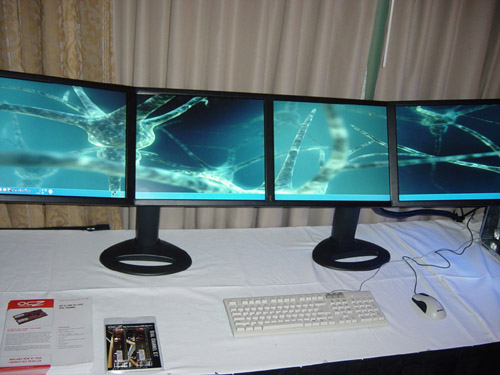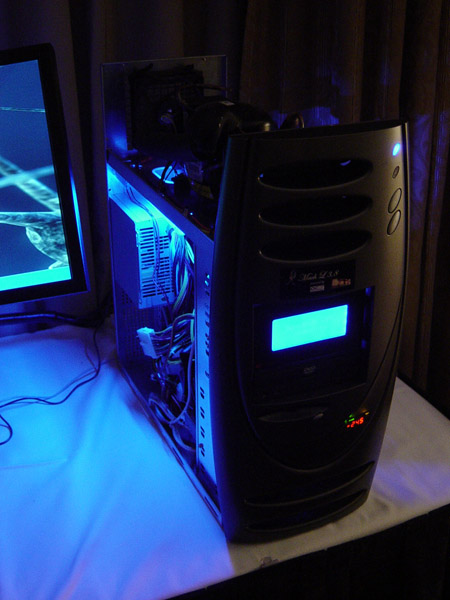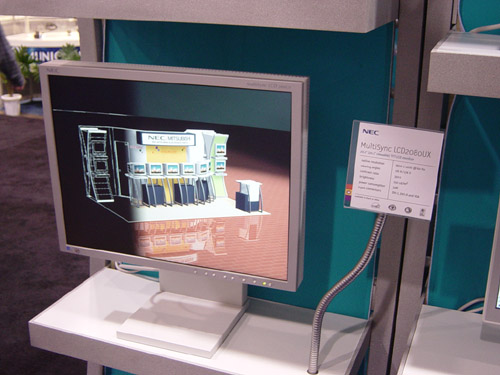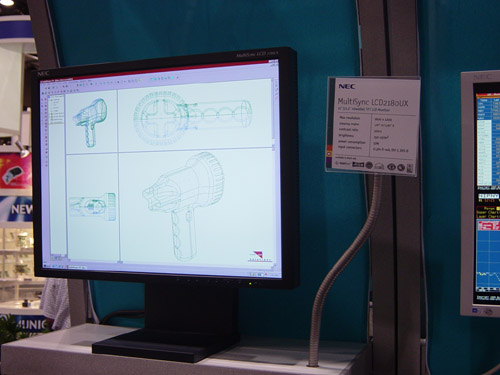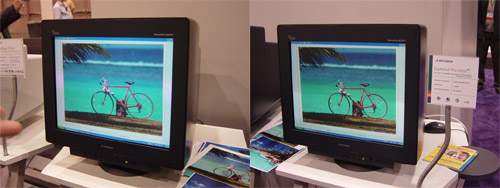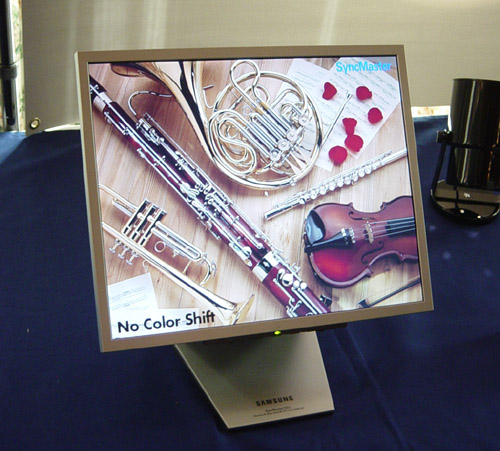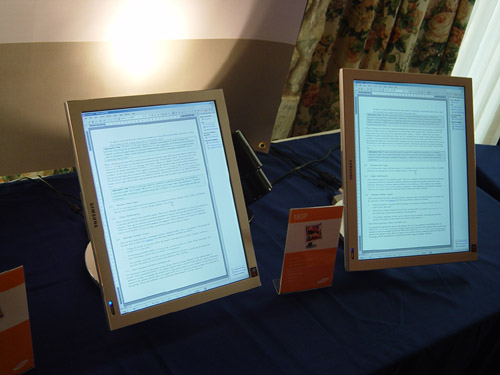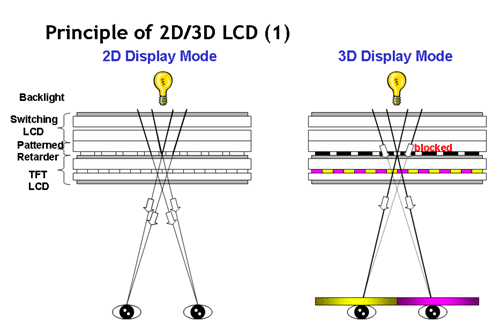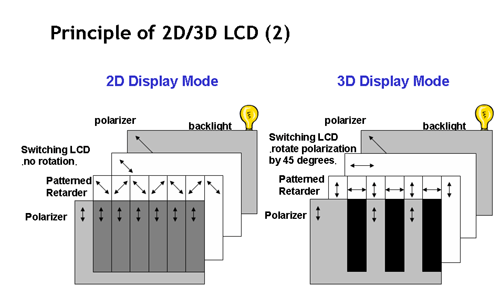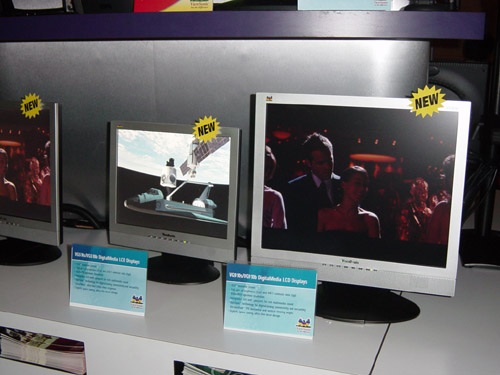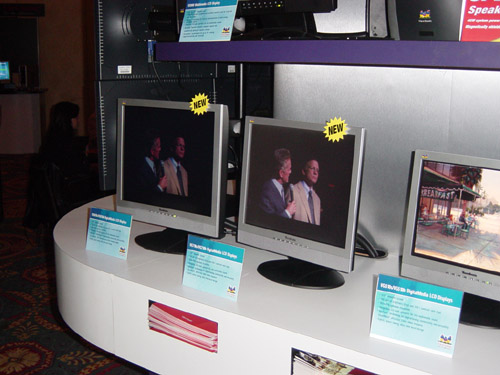
Original Link: https://www.anandtech.com/show/1199
COMDEX 2003 Display Coverage: Prelude to a CES
by Kristopher Kubicki on November 26, 2003 10:50 PM EST- Posted in
- Trade Shows
It isn't much secret that COMDEX turned out to be extremely disappointing this year. The close proximity to Computex, the low attendance rate (under 40,000) and new management all contributed to what could be the last COMDEX Las Vegas for some time. Fortunately for us, COMDEX did act as a prelude for CES (Consumer Electronic Show), which will kick off in January. This gave us a wonderful opportunity to get a sneak peak at what manufacturers will show us in January, particularly concerning LCDs.
Today, we have more than one treat for the display addicts. Our first surprise came when we bumped into the super-hyped, super-secretive Liebermann Inc in the OCZ hospitality suite. We also got to see the usual players: Samsung, NEC-Mitsubishi, Sharp, as well as some representatives from Quanta and LG Philips LCD. All in all, we brought together 3 days of display showcases into one quick cross section for our LCD coverage. Read on to find out what we thought was hot on this year's show floor.
Liebermann
Even though Liebermann only has a few selling products, they have generated quite the stir over the last few months. From fraud conspiracies to copyright problems, Liebermann spent the better part of the last 3 months just fighting off critics. Even we were a little miffed at how Liebermann was able to get products released to print magazines for review, since the demo units they displayed at the OCZ hospitality suite were clearly not finished. Regardless, the sample 4x19" Grand Canyon cinematic display was working at the booth, and we just happened to have a camera with us. Voila:Click to enlarge.
The website doesn't describe it, but signal processing comes in the form of four independent interfaces, one for each display. Unfortunately, there is not an independent signal processor on the displays to produce the 6400x1200 25X VGA over a sole interface. The particular display that we saw appears to be a 4x19" configuration, which is probably only capable of 5120x1024 anyway. Graphics were supposed to be supplied by Matrox G450's, although an alternative configuration was used for our demonstration due to technical failure.
Edit: Lisa Ciesniewski from Liebermann has informed me that the video card suite for the Grand Canyon displays is actually a Radeon 9800 XT AGP and a Radeon 9200 PCI.
In case you were wondering why we happened to bump into Liebermann at OCZ suite, it's simply because OCZ will be supplying memory for the systems. Here is an unglamorous quick shot of the demo'd workstation.
Click to enlarge.
NEC Mitsubishi
NEC-Mitsubishi is one of the most conservative players in the LCD sector. Fortunately, they had quite a bit to show off this year on the show floor (coincidently, they were also the only LCD player actually on the floor). Undoubtedly, the NEC 1760NX was one of the more successful 17" LCDs of 2002 with the AUO 16ms panel. NEC's MultiSync 2080UX is now one of the company's more popular units, particularly since it is one of the most cost-effective 20" LCDs available and is capable of 1600x1200.Unfortunately, there were no samples on the floor, but NEC is improving on the 2080UX in the same way Dell improved on the 2000FP by incorporating the LG Philips LCD LM201U04 panel. The new 2080UX+ will be capable of 16ms response times and the Super-IPS display mode.
Click to enlarge.
Also announced at the show was the 2180UX, which uses a different panel than the 2080UX in order to squeeze in that extra 0.9" of display. Unfortunately, this display does not run on 16ms technology, but is capable of 1600x1200 natively. Unfortunately, since there are not a lot of folks making 21" LCDs, this monitor will probably be somewhat cost prohibitive. Don't forget to check out our Samsung 213T analysis later this week.
Click to enlarge.
After Sony pulls the Trinitron product line next year, NEC-Mitsubishi will be one of the last companies that still produces CRT monitors. We were under the impression that NEC-Mitsubishi still has quite a strong market for the CRT with gamers and graphics designers. On the show floor, we got the opportunity to see the newer Diamond Pro 2070 SB, which incorporates a new technology to enhance color reproduction. The image on the left is the traditional 2070 22" CRT, and the one on the right is the new enhanced color model. The difference is quite noticeable.
Click to enlarge.
Samsung
It was no secret — Samsung's secret weapon this year was the US unveiling of the SyncMaster 172X. Initial European sources claimed this was only to be a 16ms LCD, but product managers from Samsung confirmed that the response time is actually closer to 12ms, with 6ms Tr and Tf. You might recall that AU Optronics was the first panel manufacturer actually to produce a 16ms LCD panel, albeit 6-bit (262,000 colors, or 16M with dithering). This was very apparent in our Hitachi CML174 review from early this year. Our Samsung sources claim that the 172X panel, made by Samsung, will be a true 8-bit panel capable of 16.7M colors. Since we have had specification inconsistencies with virtually all LCD manufacturers in the past, our methodical approach to such incredible response time claims is, “we will believe it when we see it.” (This should be within a few weeks, when we get a sample.)Click to enlarge.
You might notice the slightly new stand/bezel design. The 172X stand has been slimmed up considerably in relation to the 172T; weight has been even further distributed lower in the stand to keep the monitor stable. Once again, cable management will run outside the rear of the unit. Samsung certainly has the best cable management available right now, so our hats off to them. To sum up the rest of the monitor in a few words, the panel bezel has taken a different direction from the 172T; redesigned and narrowed for stack-ability and multi-display setups (think SyncMaster 191N). The control panel is still present, but the new preferred method for controlling contrast, brightness, etc., is done via Windows and OS 9/X software (we will get more into this during the actual product review).
Click to enlarge.
To our delight, Samsung also unveiled its 193P (above right) to us. For those of you who are horrified that Samsung discontinued the rotate and pivot functions when they upgraded the 191T to the 192T, providence comes in the form of the 193P. This really is the sleekest monitor that we saw at the show. Samsung continues their tradition of placing cable management in the base of the display. As you can see from the rear of the unit, there really isn't much on this monitor besides the panel and the stand. A certain “Applesk” look and feel is present.
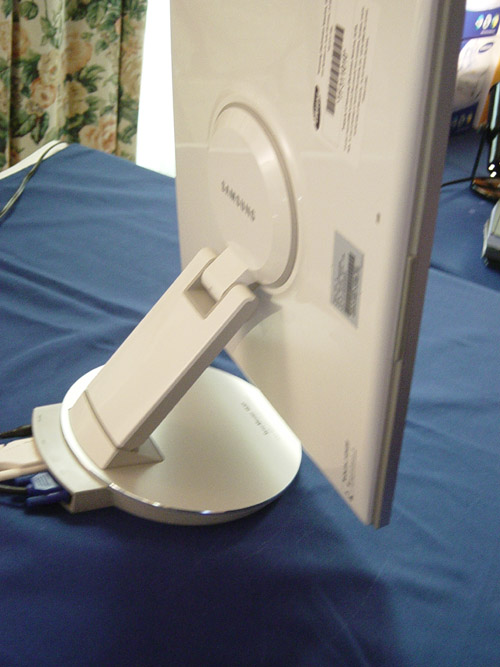
Perhaps the most interesting thing about the 193P is the lack of controls. All controls are done via Windows and Mac based software. The Power button doubles as an Auto synchronization, but everything else must be done via software. Although not many people would spend $900 or more on an LCD for a Linux workstation, you really do not even get the option to with this display. Samsung representatives commented that enough demand for Linux/Unix based drivers would probably result in additional platform ports.
Fortunately, we also got a chance to clear up some of the rumors about contrast ratio inconsistencies with the 173T and the 192T. As you may or may not know, several review sites received review panels with different specifications. As a result, the monitor in our Samsung 192T preview uses a 450:1 contrast ratio LCD, while several other samples used 600:1 (or higher) contrast ratios in their specifications. The resulting conflictions left several consumers and editors fairly confused. Our Samsung PR contact informed us that the specification change has been set back officially to 450:1. Most, if not all, 192T and 173Ts are shipping with panels capable of higher contrast ratios than advertised, but they cannot list anything better than 450:1 contrast ratios due to the existing LCDs with lower contrast ratio that are still being sold. This does not exactly differ much from original speculation, but it is good to hear a firm position from Samsung itself.
Just an interesting side note, last month Samsung and Sony agreed on a joint venture company endeavor, which would make them perhaps the largest competitor for 7th generation LCD TV production. Currently, only four companies have even announced plans for 7G production (AUO, Sharp, LG.Philips, and Samsung-Sony's new MUO).
Sharp
In case you don't know much about Sharp, they are currently the second largest LCD producer for consumer panels (17" and higher). Like Samsung, Sharp produces panels and retail LCD products, but their presence is not as strong in the US as it is in Asia or Europe. Sharp also has an enormous focus on home theater LCD products that do not quite cross over into the PC industry (Sharp is still the world's #1 LCD TV producer).Sharp was very excited to announce more details about their 6G Kameyama facility. As we mentioned before, this will be one of the largest substrate foundries in the world at a little over 3.5M sq feet and will begin full production of 1500x1800 mm substrates in January (1500x1800mm substrates allow for 16 19" panels, which is a 40% increase of Samsung's largest capability). Sharp is also able to construct its 26" - 35" LCD TV right on the campus. $500, 4th generation 19" LCDs appeal to us too!

On the heels of the incredible successful Zaurus, Sharp was also very excited to show off their 2lb, 0.55" thick Actius MM10 running Transmeta's much more capable Efficeon processor. As further introductions to the Actius line, Sharp presented its TN10W tablet and Actius AV18P DTR. Below, you can see the MM10 and the TN10W tablet:
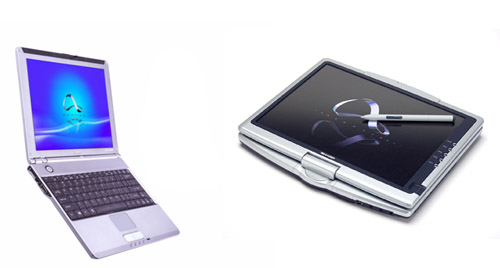
Even though tablet PCs are exciting, it's the Actius RD3D that won us over. The Actius RD3D is our COMDEX Best of Show. Why would we award a 2.8GHz laptop “best of show”? Oh, did we mention that the display allows you to toggle on 3D imagery (natively, no goggles)?! Furthermore, full production units will be shipping before the end of November. Hopefully, Andrew Ku, our mobile editor, will have an opportunity to analyze the unit thoroughly!
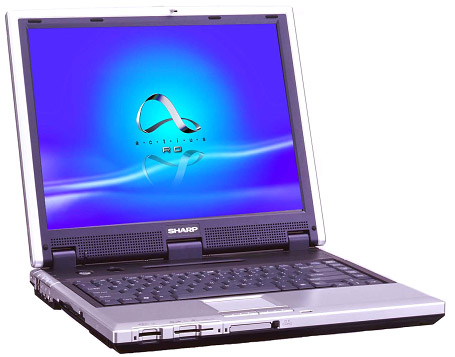
Sharp's 3D LCD
Fortunately, Sharp has a few images that can describe the technology better than we can. In a nutshell, instead of allowing the image to pass through the TFT substrate, a pattern retarder blocks alternating segments of light through the LCD. If you are sitting correctly, you will see one slightly angled image in your left eye, and a slightly different angled image in your right eye. The human brain perceives these two offset images as depth.Click to enlarge.
This is not a new concept. Using the red and blue glasses in 3D movie theaters accomplishes the same effect by filtering the red offset image via one eye and the blue offset image in the other eye. Of course, the revolutionary thing here is that we do not need goggles to achieve the same effect.
Click to enlarge.
Granted, this technology is not perfect yet. You do have to sit fairly still for the effect to work. Moving your head from left to right will result in a sort of wavy effect as you go from 3D to 2D and back to 3D. Also, since the retarding layer blocks alternate projections of the image, you actually are viewing only half of the screens capable brightness. On the other hand, this technology has a lot of promise. It is very easy to go from 2D to 3D and back, since the retarding layer can also be an LCD (power just needs to be applied over the LCD to turn it on and off). This also makes it relatively cost-effective. Furthermore, the technology is extremely capable. Even playing 2D developed games allow for an interesting degree of immersion; particularly, racing games tend to produce that 3D tunnel effect. We had the opportunity to demo a few games in the Sharp suite, and the small go-kart demo (which is natively a 2D game), produced an extremely captivating experience.
Video games will obviously be an enormous market for this emerging technology. Consider the fact that most games as we know it already exist in 3D. It is not very hard for a software driver to take two slightly different samples of UT2003 instead of one during game play, and then project both images one on top of each other to the signal output. Sharp is already working with NVIDIA and Microsoft for just that. Do not be surprised if we hear more about this technology at CES.
Sharp's next step for a technology like this would be to incorporate retina tracking capabilities in the monitor that could adjust the retarding layer to each person's eyes. As a bonus, this would allow you to move and view the 3D effect as well! Sanyo and Sony are also working on similar technology, but kudos to Sharp for being the first to bring a real world example to the world!
Quanta and LG Philips LCD
Quanta doesn't seem to fit into the LCD category, but in actuality, they have been a longtime partner with Sharp. To make a long story short, the newest trend in display manufacturer is to integrate audio and video codec DSPs directly into the display. AG Neovo began integrating SRS WOW processors into its high end X series displays around Computex. Companies like Albatron took that one step farther and began integrating DVD drives into the display as well. Since Quanta will be integrating DVD drives and DSPs into some Sharp manufacturered LCD TVs, NuTech (Quanta's retail division) will rebrand the units and market them for sale in the US and Europe. Unfortunately, at time of publication, we couldn't provide any specifications or images, but it's something on the horizon to look for!LG Philips LCD didn't actually have an official presence at COMDEX, but we had the opportunity to talk with a representative from the company to catch up on current market trends. We mentioned earlier that Sharp was dethroned recently as the number one LCD producer; but what we didn't mention was that LG Philips LCD is now currently #1. LG Philips has enjoyed incredible success over the last few months due to high volume and innovative research in the LCD sector. If you have found our COMDEX LCD coverage interesting so far, you would probably like to check out our Dell 2001FP preview published a couple weeks ago. The Dell 2001FP uses the LG Philips S-IPS 16ms panel, which we have had very positive things to say about. Remember, the LM201U04 is the world's first 16ms true 8-bit panel (and it's 20"!).
As far as other innovations with LG Philips LCD, the company has been working hard with Dell recently. Not just with the Dell 2001FP, but also with their new 17" and 30" LCD TVs (which have been doing very well apparently). NEC is also capitalizing on LG Philips LCD's wonderful panels in the form of their 30" wall-mountable displays and the upcoming 2080UX+. For those of you who are curious about the status of 16ms 17" and 19" Super IPS panels, our sources claim initial test runs on the 17" substrates is near completion and 19" will be next. We can't wait to see working samples! LG.Philips LCD will have a huge presence at CES, so we will have more news from the international LCD giant in just a few weeks.
ViewSonic
ViewSonic had one of the larger suites in the Venetian during the show. In recent months, ViewSonic brought a lot of attention to itself with the dual input VP171B, which was also based on AUO's 16ms 17" panel. The most important news from ViewSonic is the updated look and specifications on the newly revamped VG line. You can see the VG510 and the VG910 LCDs show below.Click to enlarge.
As you can see, the controls have been streamlined a bit and specifications have also been updated slightly. We are a little curious to see if the 600:1 contrast ratios really are 600:1 this time; so hopefully, we will get a sample in the lab soon. You can also see the VG810, the VG710 and part of the VG510 below as well.
Click to enlarge.
It is always exciting to see a company revamp a product line, particularly one that is very cost conscious. ViewSonic has a long way to go in order to recover the trust of consumers after their incident with NEC, particularly concerning the VG line. Stay tuned for more ViewSonic coverage in the near future.
Final Thoughts
COMDEX certainly has changed in recent shows. It is too early to speculate if COMDEX will even be around next year, but it is quite easy for us to say that CES will be the show to attend in January.For all of those wondering what we have been up to for the last couple of weeks as far as LCDs are concerned, we have some neat new stuff to look forward to. Aside from the 193P and 172X from Samsung, we are currently matching the 213T up against our reigning champion, the Dell 2001FP. We also have Albatron's incredible 30" cinematic display and samples from Sony's HS and SDM LCD lines. Hopefully, we will have some samples of ViewSonic's second generation VG line as well. We have quite a busy lineup ahead, so hang on tight!

